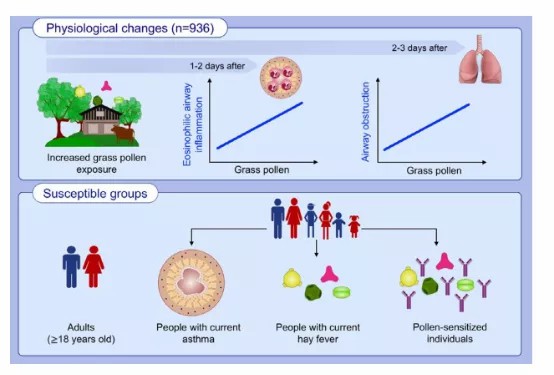Release date:2021-05-21

Allergy
[IF:6.771]
Is short-term exposure to grass pollen adversely associated with lung function and airway inflammation in the community?
DOI: 10.1111/all.14566
Abstract:
Background: The association between grass pollen exposure and early markers of asthma exacerbations such as lung function changes and increase in airway inflammation is limited. We investigated the associations between short-term grass pollen exposure and lung function and airway inflammation in a community-based sample, and whether any such associations were modified by current asthma, current hay fever, pollen sensitization, age, and other environmental factors.
Methods: Cross-sectional and short-term analyses of data from the Melbourne Atopy Cohort Study (MACS) participants (n = 936). Lung function was assessed using spirometry. Airway inflammation was assessed by fractional exhaled nitric oxide(FeNO) and exhaled breath condensate pH and nitrogen oxides (NOx). Daily pollen counts were collected using a volumetric spore trap. The associations were examined by linear regression.
Results: Higher ambient levels of grass pollen 2 days before (lag 2) were associated with lower mid-forced expiratory flow (FEF25%-75%) and FEV1/FVC ratio (Coef. [95%CI] = −119 [−226, −11] mL/s and −1.0 [−3.0, −0.03] %, respectively) and also 3 days before (lag 3). Increased levels of grass pollen a day before (lag 1) were associated with increased FeNO (4.35 [−0.1, 8.7] ppb) and also at lag 2. Adverse associations between pollen and multiple outcomes were greater in adults with current asthma, hay fever, and pollen sensitization.
Conclusion: Grass pollen exposure was associated with eosinophilic airway inflammation 1-2 days after exposure and airway obstruction 2-3 days after exposure. Adults and individuals with asthma, hay fever, and pollen sensitization may be at higher risk.
First Author:
Nur Sabrina Idrose
Correspondence:
Shyamali Dharmage, Centre of Epidemiology and Biostatistics, Melbourne School of Population and Global Health, The University of Melbourne, 207 Bouverie St, Carlton, Vic. 3052, Australia.
All Authors:
Nur Sabrina Idrose, Rachel C. A. Tham, Caroline J. Lodge, Adrian J. Lowe, Dinh Bui, Jennifer L. Perret, Don Vicendese, Edward J. Newbigin, Mimi L. K. Tang, Fahad M. Aldakheel, Nilakshi T. Waidyatillake, Jo A. Douglass, Michael J. Abramson, Eugene Haydn Walters, Bircan Erbas, Shyamali C. Dharmage
2021-05-11 Article
 hth官方网页版中国有限公司
hth官方网页版中国有限公司
